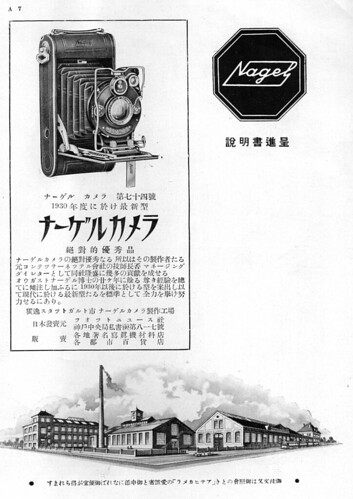Nagel

|
| Kodak-Nagel Vollenda No. 48 for 127 film image by Rick Soloway (Image rights) |
| Photo industry in Stuttgart |
| Contessa | Contessa-Nettel | Drexler & Nagel | Ebner | Hauff | Kenngott | Kodak AG | G. A. Krauss | Nagel | Zeiss Ikon |
In 1928 Dr. August Nagel, founder of Contessa and co-founder of of Zeiss Ikon, split off to start his own camera factory in his hometown Stuttgart. It produced a series of high quality folding plate and roll film cameras and became famous for its small format camera Nagel-Pupille. In 1932 the company became Kodak's German branch Kodak AG, but August Nagel remained managing director. After that, the model range continued with the Kodak name.
In the mid-1930s, Dr. Nagel devised a 35mm film cassette that would fit the successful Leica and Contax rangefinder cameras; Nagel also shrank its earlier Vollenda camera to fit this smaller format—creating the Retina). Kodak in the US promoted this new film packaging as 135 format, and it soon became the 35mm standard that is universal today.
Contents
Cameras

|
| Advertisement in Asahi Camera February 1930, showing the Nagel No.714. (Image rights) |
Rigid
Folding
| Vollenda No. | 48 | (50), 52 | 60 | 68, 70, 72 | 80 |
|---|---|---|---|---|---|
| Image size (ca.) | 3 x 4 cm | 4 x 6.5 cm | 5 x 7.5 cm | 6 x 9 cm | 6.5 x 11 cm |
| Film type | 127 | 129 | 120 | 116 | |
| Focal length | 5 cm | 7.5 cm | 9 cm | 10.5 cm | 12 cm |
The series was introduced in 1929 with the models 60, 70, and 80. The other models followed in 1930 and 1931 (48). Many of them continued in production after Kodak took over the company in 1932 as "Kodak Vollenda" with the same model numbers. In 1934 the larger roll film types were consolidated into the newly introduced...
Film plates
- Anca 14
- Recomar 18
- Recomar 33
- Nagel Fornidar (9x12)
Links
- Further Thoughts on August Nagel, by Larry Gubas, at Zeiss Historica, vol. 29, Fall 2007, pages 21-22.
- August Nagel and the Retina, by Peter Wallage, at Zeiss Historica, vol. 27, Fall 2005, pages 10-15.
- Zeiss Ikon and Dr. August Nagel (History), by Larry Gubas, at Zeiss Historica, vol. 6, Spring 1984, page 4.
- August Nagel-Werke at Brian Wallen's Cameras of Kodak's Golden Age
- Historical Society for Retina Cameras
- Retina Rescue - Chris's Camera Pages, by Chris Sherlock
- Original Retina by Sylvain Halgand (in French)
- Nagel page at Collection G. Even's site (in French)